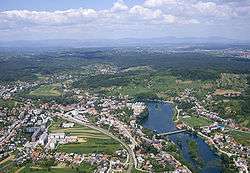Please tell us which country and city you'd like to see the weather in.

Duga Resa
Duga Resa is a town in Karlovac County, Croatia. It is located about 65 km southwest of Zagreb and 100 km east of Rijeka.
Name
The earliest reference to Duga Resa is from the year 1380. There are several theories on how the then-village acquired its name: one is that "resa" is a reference to the town people's folk costumes; another is that it is named from a native plant that grows in the area, both on the land and in the water.
Population
The village soon grew into a town during the industrialization of the area in the late 19th and early 20th century. In the 2001 census, there were 12,114 inhabitants in the municipality, 96% of which were Croats.
In 2011, the total population is 11,180, in the following settlements:

Resa
Resa (pronounced [ˈɾeːsa]; German: Ressen) is a remote abandoned settlement in the Municipality of Semič in southern Slovenia. The area is part of the traditional region of Lower Carniola and is now included in the Southeast Slovenia Statistical Region. Its territory is now part of the village of Komarna Vas.
History
Resa was a Gottschee German village. It was founded after 1558 and initially consisted of two half-farms. In 1770 it had four houses, and in 1931 three houses. The original inhabitants were expelled in the fall of 1941. The village was burned by Italian troops in the summer of 1942 during the Rog Offensive and it was never rebuilt.
References
External links
Runway safety area
A runway safety area (RSA) or runway end safety area (RESA) is defined as "the surface surrounding the runway prepared or suitable for reducing the risk of damage to airplanes in the event of an undershoot, overshoot, or excursion from the runway."
Past standards called for the RSA to extend only 60m (200 feet) from the ends of the runway. Currently the international standard ICAO requires a 90m (300 feet) RESA starting from the end of the runway strip (which itself is 60m from the end of the runway), and recommends but not requires a 240m RESA beyond that. In the U.S., the recommended RSA may extend to 500 feet in width, and 1,000 feet beyond each runway end (according to U.S. Federal Aviation Administration recommendations; 1000 feet is equivalent to the international ICAO-RESA of 240m plus 60m strip). The standard dimensions have increased over time to accommodate larger and faster aircraft, and to improve safety.
Historical development
In the early years of aviation, all airplanes operated from relatively unimproved airfields. As aviation developed, the alignment of takeoff and landing paths centered on a well defined area known as a landing strip. Thereafter, the requirements of more advanced airplanes necessitated improving or paving the center portion of the landing strip. The term "landing strip" was retained to describe the graded area surrounding and upon which the runway or improved surface was constructed.
Radio Stations - Duga Resa
SEARCH FOR RADIOS
Podcasts:

-
by 98 Degrees
-
by 98 Degrees
-
by 98 Degrees
-
by 98 Degrees
-
by 98 Degrees
-
by 98 Degrees
-
by 98 Degrees
-
by 98 Degrees
-
by 98 Degrees
-
by 98 Degrees
-
by 98 Degrees
-
by 98 Degrees
-
by 98 Degrees
-
by 98 Degrees
-
by 98 Degrees
-
by 98 Degrees
-
by 98 Degrees
-
by 98 Degrees
-
by 98 Degrees
-
by 98 Degrees
-
by 98 Degrees
-
by 98 Degrees
-
by 98 Degrees
-
by 98 Degrees
-
by 98 Degrees
-
by 98 Degrees
-
by 98 Degrees
-
by 98 Degrees
-
by 98 Degrees
-
by 98 Degrees
-
by 98 Degrees
-
by 98 Degrees
-
by 98 Degrees
-
by 98 Degrees
-
by 98 Degrees
-
by 98 Degrees
-
by 98 Degrees
-
by 98 Degrees
-
by 98 Degrees
-
by 98 Degrees
-
by 98 Degrees
-
by 98 Degrees
-
by 98 Degrees
-
by 98 Degrees
-
by 98 Degrees
-
by 98 Degrees
-
by 98 Degrees
-
by 98 Degrees
-
by 98 Degrees
-
by 98 Degrees
Never Giving Up
by: 98 DegreesTell me what's been going on
How did our love go so wrong
Cause I know that I made some mistakes
Oh baby
Girl it's written on your face
That you gonna walk way
And you said that your feeling's changed
I know you still need me
I can see it in your eyes
You're afraid of your feelings
But girl you can't deny
CHORUS
You know I've tried a thousand times
To win your love
But it's never enough
It's been a dream for you and me
Girl can't you see
That I'm not giving up
I'm never giving up
All I need is one more chance
Don't give up on this romance
I don't want nothing but a change
So don't go wasting your time
Looks like this is hard to find
I'm right here I swear I'll be waiting
Oh baby
Deep down you're hurting
I can see it in your eyes
I know you still want me
But you have to realize
Repeat chorus
You know I've tried so long
Just to win your love
You should know by now
I'm never giving up
Dream of you and me
Baby can't you see
I'm never giving up
